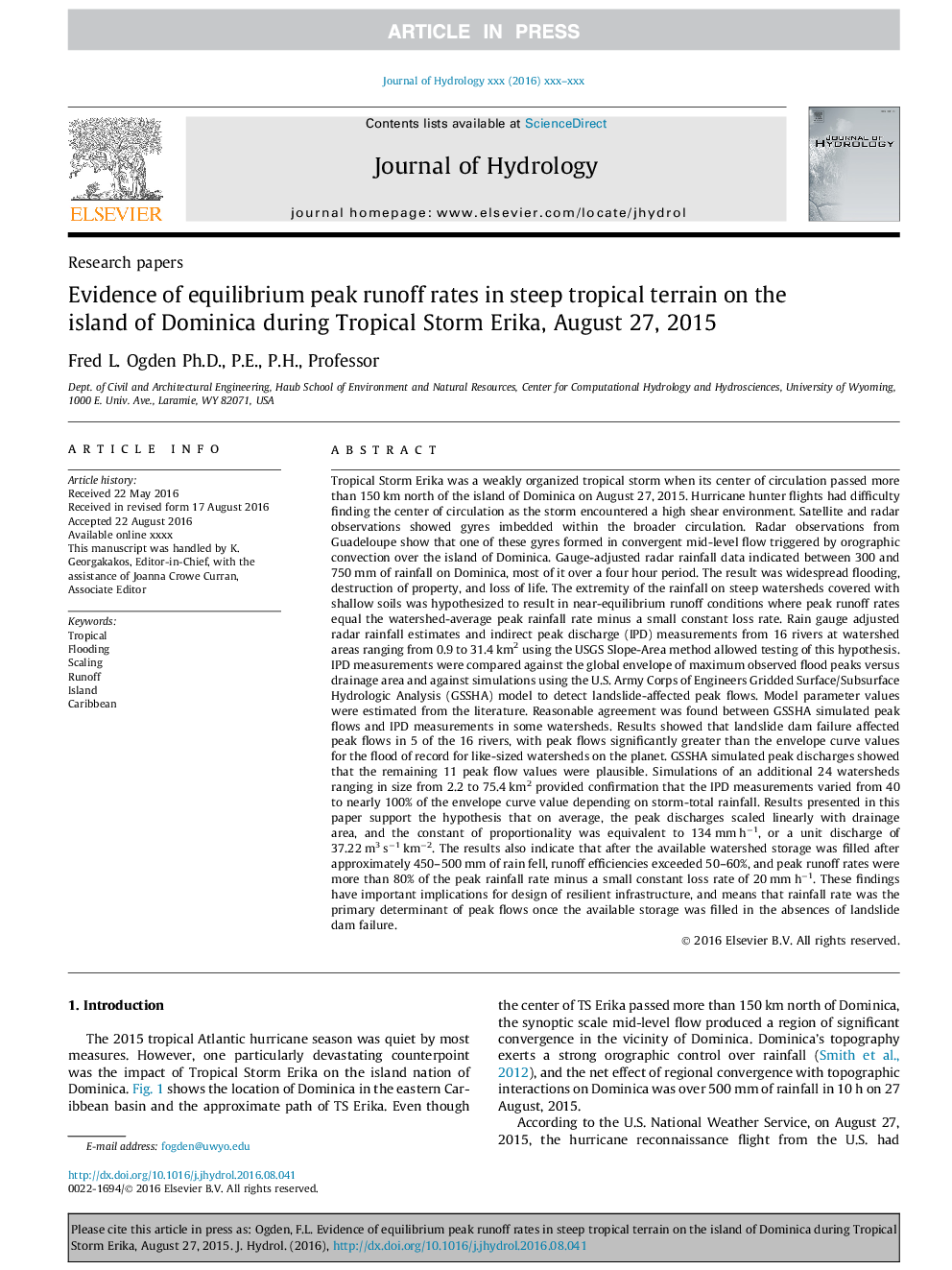| کد مقاله | کد نشریه | سال انتشار | مقاله انگلیسی | نسخه تمام متن |
|---|---|---|---|---|
| 6409221 | 1629911 | 2016 | 13 صفحه PDF | دانلود رایگان |
عنوان انگلیسی مقاله ISI
Evidence of equilibrium peak runoff rates in steep tropical terrain on the island of Dominica during Tropical Storm Erika, August 27, 2015
ترجمه فارسی عنوان
شواهدی از میزان رواناب صاف تعادل در حوضه های شیب دار گرمسیری در جزیره دومینیکا در طوفان گرمسیری اریکا، 2015 اوت 27
دانلود مقاله + سفارش ترجمه
دانلود مقاله ISI انگلیسی
رایگان برای ایرانیان
کلمات کلیدی
گرمسیری سیلاب، مقیاس رواناب جزیره، کارائیب،
موضوعات مرتبط
مهندسی و علوم پایه
علوم زمین و سیارات
فرآیندهای سطح زمین
چکیده انگلیسی
Tropical Storm Erika was a weakly organized tropical storm when its center of circulation passed more than 150 km north of the island of Dominica on August 27, 2015. Hurricane hunter flights had difficulty finding the center of circulation as the storm encountered a high shear environment. Satellite and radar observations showed gyres imbedded within the broader circulation. Radar observations from Guadeloupe show that one of these gyres formed in convergent mid-level flow triggered by orographic convection over the island of Dominica. Gauge-adjusted radar rainfall data indicated between 300 and 750 mm of rainfall on Dominica, most of it over a four hour period. The result was widespread flooding, destruction of property, and loss of life. The extremity of the rainfall on steep watersheds covered with shallow soils was hypothesized to result in near-equilibrium runoff conditions where peak runoff rates equal the watershed-average peak rainfall rate minus a small constant loss rate. Rain gauge adjusted radar rainfall estimates and indirect peak discharge (IPD) measurements from 16 rivers at watershed areas ranging from 0.9 to 31.4 km2 using the USGS Slope-Area method allowed testing of this hypothesis. IPD measurements were compared against the global envelope of maximum observed flood peaks versus drainage area and against simulations using the U.S. Army Corps of Engineers Gridded Surface/Subsurface Hydrologic Analysis (GSSHA) model to detect landslide-affected peak flows. Model parameter values were estimated from the literature. Reasonable agreement was found between GSSHA simulated peak flows and IPD measurements in some watersheds. Results showed that landslide dam failure affected peak flows in 5 of the 16 rivers, with peak flows significantly greater than the envelope curve values for the flood of record for like-sized watersheds on the planet. GSSHA simulated peak discharges showed that the remaining 11 peak flow values were plausible. Simulations of an additional 24 watersheds ranging in size from 2.2 to 75.4 km2 provided confirmation that the IPD measurements varied from 40 to nearly 100% of the envelope curve value depending on storm-total rainfall. Results presented in this paper support the hypothesis that on average, the peak discharges scaled linearly with drainage area, and the constant of proportionality was equivalent to 134 mm hâ1, or a unit discharge of 37.22 m3 sâ1 kmâ2. The results also indicate that after the available watershed storage was filled after approximately 450-500 mm of rain fell, runoff efficiencies exceeded 50-60%, and peak runoff rates were more than 80% of the peak rainfall rate minus a small constant loss rate of 20 mm hâ1. These findings have important implications for design of resilient infrastructure, and means that rainfall rate was the primary determinant of peak flows once the available storage was filled in the absences of landslide dam failure.
ناشر
Database: Elsevier - ScienceDirect (ساینس دایرکت)
Journal: Journal of Hydrology - Volume 542, November 2016, Pages 35-46
Journal: Journal of Hydrology - Volume 542, November 2016, Pages 35-46
نویسندگان
Fred L. Ph.D., P.E., P.H., Professor,
